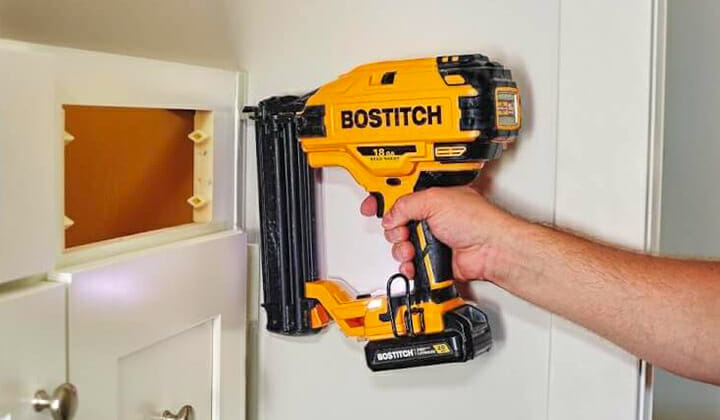Pneumatic nailer lubrication schedule: A consistent oiling routine prevents jams, extends tool life, and ensures powerful nail drives. Follow this essential guide for a happy nailer!
Hey there, fellow DIYers and woodworking enthusiasts! Jack Shaffer here from Nailerguy. Ever feel like your trusty pneumatic nailer is a bit… sluggish? Maybe it’s not driving nails with the same punch it used to, or worse, it’s jamming more often than you’d like. It’s a frustrating problem, but I’ve got good news: the fix is often simple and surprisingly quick.
Many of these common issues stem from a single, often overlooked, maintenance task: proper lubrication. It’s not complicated, and it’s one of the best ways to keep your air-powered nail gun running smoothly and reliably for years to come. In this guide, we’ll break down exactly why, when, and how to lubricate your pneumatic nailer so you can get back to building with confidence. Let’s dive in!
Table of Contents
Why Lubrication is Crucial for Your Pneumatic Nailer
Think of your pneumatic nailer like a tiny, powerful engine powered by compressed air. Inside, there are many moving parts, including pistons, O-rings, and seals, that slide against each other at high speeds. Without the right lubrication, these parts can experience:
Increased Friction: Dry metal-on-metal contact creates friction, which leads to wear and tear.
Heat Buildup: Friction generates heat, which can warp or damage delicate internal components.
Corrosion: Moisture in the air can cause rust and corrosion on internal metal parts.
Premature Wear: These factors combined can drastically shorten the lifespan of your nailer.
Regular lubrication is your best defense against these problems. It acts as a protective barrier, reducing friction, preventing rust, and keeping everything moving freely.
The Minimal Lubrication (ML) vs. Oil-Lubricated Nailers
It’s important to know that not all pneumatic nailers are created equal when it comes to lubrication.
Oil-Lubricated Nailers: Most common framing nailers, finishing nailers, and brad nailers fall into this category. They have a small oil reservoir or a port where you add a few drops of specialized pneumatic tool oil. These are the tools we’ll focus on for our lubrication schedule.
Minimal Lubrication (ML) or Oil-Free Nailers: Some modern nailers, particularly certain brad and finish nailers, are designed to operate with little to no regular lubrication from the user. They often have internal materials that self-lubricate or are designed for dry running. Always check your tool’s manual to confirm if it’s an ML or oil-free model. If it has an oil port, it needs oil!
Benefits of a Proper Lubrication Schedule
Sticking to a regular lubrication schedule offers some fantastic benefits:
Extended Tool Lifespan: By minimizing internal wear and tear, you’ll keep your nailer from wearing out prematurely.
Consistent Performance: A well-lubricated nailer fires nails with consistent power and accuracy.
Reduced Jams and Misfires: Smoothly moving parts mean fewer obstructions and better overall operation.
Protection Against the Elements: Lubricant helps repel moisture that can cause rust, especially important in humid or outdoor working conditions.
Quieter Operation: Sometimes, lubrication can even help reduce the noise your tool makes.
Pneumatic Nailer Lubrication Schedule: How Often and How Much
So, the big question: how often should you lubricate your nailer? The answer isn’t a single, fixed number because it depends on several factors. However, we can provide a reliable framework.
Key Factors Influencing Lubrication Frequency
1. Usage Intensity:
Light Use: If you only use your nailer for occasional small projects (a few hundred nails per month), a monthly check and lubrication might be sufficient.
Moderate Use: For weekend warriors or DIYers tackling larger projects, a weekly or every few hundred nails schedule is a good starting point.
Heavy/Professional Use: If your nailer is your daily workhorse, you’ll want to lubricate it daily, or even after every major task or every refill of the air tank.
2. Environment:
Humid or Dusty Conditions: If you’re working in a damp garage, outdoors in humid weather, or in a very dusty environment, you may need to lubricate more frequently. Dust and moisture are the enemies of pneumatic tools.
Clean Conditions: A clean, dry workshop might allow for slightly extended intervals.
3. Tool Type and Age:
Older tools might benefit from slightly more frequent attention as seals can dry out.
Some framing nailers, designed for high power output, might require more frequent lubrication than a lightweight finish nailer.
The Nailerguy Recommended Lubrication Schedule Framework
Here’s a practical schedule to follow. Remember, it’s always best to err on the side of more frequent lubrication if you’re unsure.
Daily/Heavy Use: Add 1-2 drops of pneumatic tool oil through the air inlet port at the start of each day or after a significant work session.
Weekly/Moderate Use: Add 1-2 drops of oil at the start of your first project of the week. Check the oil level if your tool has a visible reservoir.
Monthly/Light Use: Add 1-2 drops of oil at the start of your first project of the month.
After Each Air Tank Refill (for heavy users): Some pros find this cadence helpful to ensure consistent performance throughout a long workday.
Crucially, always consult your nailer’s owner’s manual. It’s the ultimate authority for your specific tool and may provide a more precise recommendation.
How to Lubricate Your Pneumatic Nailer: A Step-by-Step Guide
Lubricating your nailer is a straightforward process. Here’s how to do it safely and effectively:
Tools and Supplies You’ll Need:
Pneumatic Tool Oil: This is critical. Do not use WD-40, motor oil, or household lubricants. They can damage the O-rings and seals inside your nailer. Look for dedicated “pneumatic tool oil” or “air tool oil.” Brands like DeWalt, Senco, Bostitch, and generic air tool oil are readily available.
A Clean Cloth or Paper Towels: For wiping away excess oil and debris.
Safety Glasses: Always protect your eyes!
Gloves (Optional): To keep your hands clean.
The Lubrication Process:
Step 1: Disconnect Air Supply
This is the MOST important safety step. Always disconnect the air hose from your nailer before performing any maintenance, including lubrication. This prevents accidental firing.
Step 2: Locate the Air Inlet Port
This is where the air hose connects to your nailer. It’s usually a threaded fitting at the top or rear of the tool.
Step 3: Add the Oil
Using the bottle or applicator for your pneumatic tool oil, carefully add 1 to 2 drops directly into the air inlet port. Some nailers have a small cap or cover over this port; you may need to remove it first. Be sparing – too much oil can actually cause issues like a weakened drive or oil spitting out the exhaust.
Step 4: Reconnect Air Supply
Securely reattach the air hose to the nailer’s air inlet port.
Step 5: Fire a Few Test Nails
Now, point the nailer at a scrap piece of wood (never at a person or pet!). Fire 5-10 nails. This helps distribute the oil throughout the internal mechanisms and also clears any excess oil from the exhaust. You might see a small puff of smoke or oil vapor from the exhaust the first few times – this is normal.
Step 6: Wipe Down the Tool
Use a clean cloth to wipe away any excess oil from the exterior of the nailer.
What Type of Oil Should You Use?
As mentioned, using the correct lubricant is vital. Pneumatic tool oil is specifically formulated to:
Maintain its viscosity across a range of temperatures.
Protect against rust and corrosion.
Be compatible with the rubber and plastic seals and O-rings found in air tools.
Evaporate cleanly without leaving gummy residue.
Commonly recommended oils are ISO 32 or ISO 46 viscosity grades. If your manual doesn’t specify, a general-purpose pneumatic tool oil is a safe bet. You can find it at most hardware stores, big-box home improvement centers, and online tool retailers.
Advanced Maintenance: Beyond Daily Lubrication
While regular oiling is the cornerstone of pneumatic nailer maintenance, a few other practices will keep your tool in top shape.
Regular Cleaning
Dust, wood shavings, and debris can accumulate both externally and internally.
External Cleaning: Wipe down the exterior of your nailer regularly with a dry cloth. For tougher grime, a slightly damp cloth (water only) can be used, but ensure the tool is completely dry afterward. Keep the exhaust port clear of debris.
Internal Cleaning (Less Frequent): Some professionals recommend “burping” the tool (firing it rapidly without nails) periodically to help blow out loose debris. More thorough internal cleaning might involve partially disassembling the nailer, but this is best left to experienced users or when troubleshooting persistent issues. Always refer to your manual before attempting any disassembly.
Air Quality: The Importance of Dry Air
Moisture in your compressed air system is a major enemy of pneumatic tools. Water can cause rust, freeze in cold temperatures, and wash away lubricant.
Drain your Air Compressor Tank Regularly: Most air compressors have a drain valve at the bottom of the tank. Open this valve periodically to release accumulated water. How often depends on your usage and ambient humidity, but a good practice is to do it after every use or at least weekly.
Use an Air Filter/Water Separator: Installing a good quality filter/water separator between your compressor and your nailer is one of the best investments you can make for your air tools. These devices remove moisture, oil, and dirt from the compressed air before it reaches your tool, significantly extending its life and improving performance. Resources like those from OSHA emphasize the importance of maintaining clean and safe compressed air systems for worker safety and equipment longevity.
Inspecting O-rings and Seals
Over time, the rubber O-rings and seals inside your nailer can dry out, crack, or wear down. This can lead to air leaks, reduced power, or oil bypassing its intended path.
Listen for Leaks: If you hear a steady hiss of air escaping from your nailer while it’s connected to air pressure (but not firing), it could indicate a worn seal.
Visual Inspection: If you’re comfortable, you can sometimes perform a basic visual inspection of the nose of the tool or the magazine area for obvious signs of wear or damage.
Professional Service: For significant re-sealing or repairs, it’s often best to take your nailer to an authorized service center or a tool repair professional.
Troubleshooting Common Nailer Issues with Lubrication
Sometimes, the symptoms of a lubrication problem are the first sign that something needs attention.
Symptom: Weak Nail Drives
Possible Cause: Not enough oil, or the wrong type of oil used. Insufficient lubrication means increased friction, and internal parts aren’t cycling as efficiently, leading to less forceful piston movement.
Solution: Ensure you’re using the correct pneumatic tool oil. Follow the schedule diligently, adding 1-2 drops. Check your air compressor’s pressure setting – make sure it’s adequate for the nailer’s requirements.
Symptom: Frequent Jams and Misfires
Possible Cause: Lack of lubrication is causing parts to stick or not move freely. Debris can also get lodged more easily in unlubricated mechanisms.
Solution: Lubricate your tool as recommended. Fire a few test nails to ensure the oil is distributed. Clean any visible debris from the magazine and nose area.
Symptom: Oily Residue on Nails or Workpiece
Possible Cause: Too much oil has been added. Excess oil can be pushed out of the exhaust port or other areas by the compressed air.
Solution: Back off the amount of oil you’re adding. Stick to the 1-2 drops recommended. After lubricating, fire several test nails into scrap wood to help expel the excess.
Symptom: Slow Piston Return
Possible Cause: Friction from lack of lubrication is hindering the piston’s movement.
Solution: Add a couple of drops of pneumatic tool oil and cycle the tool a few times. This should help free up the piston.
Symptom: Tool “Sputters” or Sounds Rough
Possible Cause: Often a sign of internal parts not cycling smoothly due to a lack of lubrication.
* Solution: Lubricate the air inlet and cycle the tool. Ensure your air compressor is providing clean, dry air.
Pneumatic Nailer Lubrication Schedule Table
To make things even clearer, here’s a quick reference table:
| Usage Level | Frequency | Action | Notes |
|---|---|---|---|
| Heavy/Daily Use | Daily or after every air tank refill | Add 1-2 drops of pneumatic tool oil to air inlet | Ensures consistent performance throughout long work periods. |
| Moderate/Weekend Use | Weekly or every ~500-1000 nails | Add 1-2 drops of pneumatic tool oil to air inlet | A good balance for regular DIY projects. |
| Light/Occasional Use | Monthly or before major project | Add 1-2 drops of pneumatic tool oil to air inlet | Just to ensure it’s ready to go. |
| After Extended Storage | Before first use after long break | Add 1-2 drops of pneumatic tool oil to air inlet | Helps re-lubricate dry internal parts. |
| Humid/Dusty Conditions | More frequently than recommended for usage level | Add 1-2 drops of pneumatic tool oil to air inlet | Environmental factors increase wear. |
FAQ: Your Pneumatic Nailer Lube Questions Answered
Q1: How many drops of oil should I put in my pneumatic nailer?
A1: Generally, 1 to 2 drops of dedicated pneumatic tool oil are sufficient. More is not better and can lead to problems like oil spitting and weakened drives.
Q2: Can I use any kind of oil in my pneumatic nailer?
A2: Absolutely not! You must use specialized pneumatic tool oil. Oils like motor oil, WD-40, or general household lubricants can damage the internal O-rings and seals, leading to premature tool failure.
Q3: My nailer is new, does it need oil right away?
A3: Most new pneumatic nailers come pre-lubricated from the factory and are ready to use. However, it’s always a good idea to check your owner’s manual. Some manufacturers recommend adding a couple of drops after the first few hundred nails to ensure proper break-in lubrication.
Q4: What if I forget to lubricate my nailer for a while?
A4: If you notice decreased performance (weak drives, slow action) or increased jams, give your nailer a couple of drops of oil and cycle it a few times. Then, continue with your regular schedule. However, prolonged neglect without lubrication can accelerate wear on internal parts, potentially shortening the tool’s lifespan.
Q5: Does my air compressor’s lubricator affect my nailer’s needs?
A5: If you use an in-line lubricator on your air hose, it provides a continuous supply of oil to all tools connected. In this case, you might not need to add oil directly to the nailer’s air inlet as often, or at all, depending on the lubricator’s setting and your tool’s requirements. However, it’s still wise to check your specific nailer’s manual. For nailers that require direct oiling (often due to their design or higher power requirements), the in-line lubricator is usually considered supplemental, and 1-2 drops directly into the tool periodically is still recommended for optimal performance.
Q6: What’s the difference between oil-lubricated and oil-free nailers?
A6: Oil-lubricated nailers require regular oil additions to their air inlet for internal lubrication. Oil-free nailers, often lighter-duty brad or finish nailers, use internal materials that don’t require routine oiling from the user. Always confirm your tool type with its manual.
Q7: How do I know if my nailer is leaking air?
A7: Disconnect all air hoses and make sure the trigger is not depressed. Listen closely for a continuous hissing sound coming from the nailer. If you hear one, it’s likely a worn O-ring or seal somewhere internally, which might require professional attention or a replacement kit.
Conclusion: Your Nailer Will Thank You!
Keeping your pneumatic nailer happy and healthy is surprisingly simple once you get into the routine. A few drops of the right oil applied at the right times is the secret to unlocking consistent performance and extending the life of this valuable tool.
By following this guide, you’re not just




